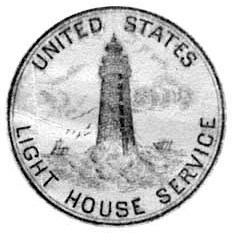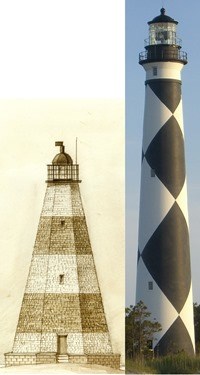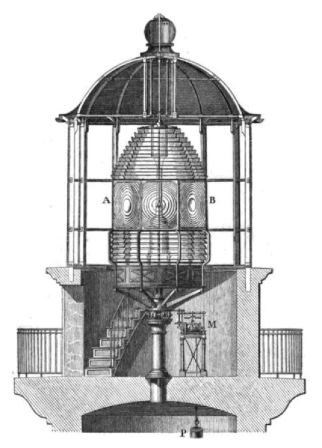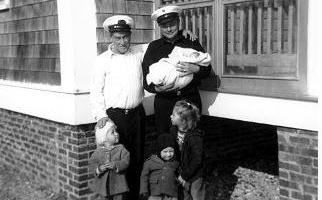
Origins of the Light House ServiceFrom very early on, North American colonists recognized the need to establish lighthouses to protect ships traveling along the coast. Some lighthouses were created to warn ships away from dangerous areas while others were meant to guide mariners into safe harbor. Initially, these lighthouses were built and maintained by towns or states. In 1789, all the existing lighthouses, beacons, and buoys were brought under the control of the federal government. Through the years, this governing body went through several changes in structure and leadership which impacted both the lights being built and how and by whom they were maintained. For more information on the history of the Light House Service, visit the U.S. Coast Guard's Lighthouses, Lightships, Tenders & Other Aids to Navigation webpage. 
Cape Lookout Lighthouse(s)The first Cape Lookout lighthouse was authorized by Congress in 1804 and completed in 1812. As with most lighthouses, one Keeper was assigned to the station to maintain the light. A Keeper's Quarters was built near the light to house the Keeper and his family since he might be called upon at any time, in the event of a sudden storm, to light the light. Unfortunately, the light from this 107-foot tall tower only reached about 12 miles out to sea and complaints were soon made about the effectiveness of this lighthouse. Following the development of the Lighthouse Board, funding for the replacement and repair of lighthouses increased. In 1857, Congress appropriated money for the creation of a new lighthouse at Cape Lookout, which was completed two years later. Shortly before the second tower was completed, two Assistant Keepers were appointed to the Cape Lookout Light Station. This allowed each Keeper to work one 24-hour period followed by two days off. These three Keepers were housed in the 1812 Keeper's Quarters and 1812 Lighthouse. Later, additional housing would be built to accommodate the Keepers and their families. 
Daily DutiesKeeping the light lit may seem like a simple task, but in reality there was a lot of work involved in maintaining a lighthouse. The light had to be burning from sunset to sunrise every day and during any daytime storms that obscured visibility. Before electricity, oil was used to fuel the light. At Cape Lookout, two 5-gallon cans of whale oil or kerosene (weighing about 45 pounds each) had to be carried up the 216 steps to the lantern room at least once per day. The keepers may have lightened their load by hauling the oil up the outside of the tower using ropes and horses. The lamp wicks had to be trimmed every four hours to prevent the burnt ends from producing smoke that would cover the glass lens, dimming the light. This task earned Keepers the nickname "wickies." There were more than 1,000 glass prisms which composed the almost 8 foot tall First Order Fresnel (pronounced Frey-nell) lens used in the Cape Lookout lighthouse. These prisms as well as the lamps, reflectors, brass fittings, windows, and steps had to be cleaned every day. Keepers were also responsible for keeping detailed records of the oil and other supplies they received and used. And, the lighthouse, Keeper's Quarters, and support buildings would need to be periodically painted and repaired. 
Life at the LighthouseDuring their time off, keepers still worked to provide for their families. Despite the sandy terrain, many keepers tended gardens to supplement their flour and food allotment. Most of these families also kept livestock, such as cows, goats, sheep, chickens, and horses. Because they lived on an island, they did not fence the animals into a pen, but fenced them out of the gardens. Generally, the lighthouse keepers at Cape Lookout would be allowed to have their families with them on the island. However, there were no schools on the island. This meant that children would either be homeschooled, some with old textbooks from Harkers Island Elementary, or they would live with their mothers or other relatives on the mainland during the school year. That meant that some keepers might spend months at a time either away from their families or only seeing them on the weekends. The tedious workload and isolation could take its toll. Depression and alcoholism were common among keepers. Some of the Cape Lookout keepers occupied themselves reading the books that were delivered with the weekly mail. Until 1899, the keepers could also walk to a small community known as Diamond City, located on Shackleford Banks. At other times, the keepers would provide valuable assistance to the crew of the Cape Lookout Life-Saving Station, including during the rescue of the Olive Thurlow. In addition, the Cape Lookout lighthouse was not always as lonely as some other duty stations because there were three keepers instead of one. As technology became more advanced, the duties of the light keepers decreased. In 1939, the Light House Service was absorbed into the newly established Coast Guard. The Cape Lookout lighthouse came under the watch of the Coast Guard Station located about two miles south of the lighthouse. When that station was decommissioned, the Fort Macon Station became responsible for maintaining this light, a duty they continue to this day. |
Last updated: October 20, 2023
